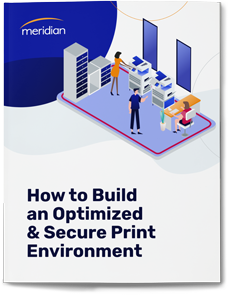
Modern technology has completely redefined what it means to maximize productivity and efficiency, and organizations are adopting new advanced tools and solutions to try to keep up.
However, the never-ending race for better connectivity and digital relevance in modern offices has resulted in many organizations funding new IT initiatives without having a clear picture of both the costs and the risks associated with them. This is especially the case when it comes to investments in multifunction printers (MFPs) and high volume print networks.
Today’s MFPs are more advanced than ever before, serving as an all in-one solution for print, fax, scan, and email functionalities as well as maximizing output and efficiency. But in the current digital landscape, more connectivity equates to higher security risks, and large volume devices like MFPs are especially at risk for malicious attacks and data breaches. Also, the costs associated with heavy unmonitored usage of these devices can quickly impact an organization’s ability to maintain its budgets as well as control its environmental impact.
Optimizing and hardening network printing environments can help offices significantly improve their IT security efforts, while also managing sustainable costs and better control of their environmental footprint. Below is a practical guide to follow when taking steps to maximize efficiency and security in your print environment.

Not a problem! Enter your email below for a downloadable PDF version that you can get to read on your own time.
The fact is, most facilities invest in MFPs because of their convenience and ease of use. Rather than restricting the use of these devices, most organizations give their employees quick access to their printing needs without placing restrictions on how they are used. However, a common
issue plaguing many organizations when it comes to equipment maintenance costs has to do with printer supply waste and abuse.
Here are some best practices you can follow when enforcing better printer usage standards.
Print management software is designed to create better transparency over the volume and frequency of your printer usage. Having better visibility over how your MFP is being used will help you gain insight when identifying peak usage times, rate of hardware issues, and how
fast your printer supplies are depleting. Having an effective solution in place to automate the administrative processes behind managing your MFP not only helps to reduce staffing costs but also enables you to establish and enforce better printing practices.
In order to make better decisions around how your MFP is currently being used, it’s first essential to track key printing metrics on a day-to-day basis. Some of these metrics can include:
Implementing print management software makes tracking these metrics accurate and seamless, and will provide you with the information you need to make the necessary adjustments in areas of concern.
Another benefit of investing in print management software is that it provides you with the ability to create and enforce sustainable printing policies with your employees. These policies play a critical role in ensuring your organization gives due diligence to reducing waste and minimizing its environmental footprint. There are a variety of procedures that can be monitored and enforced when deploying print management software, including:
When most organizations consider their cybersecurity preparedness, many limit their focus to mission-critical systems, database storage, and networked computers. However, as technology continues to advance, so do the risks associated with using newer, more innovative printing solutions. Modern MFPs in office environments typically see an overwhelming amount of network traffic from laptops, phones, and other connected devices. It’s due to this fact that administrators need to take the necessary steps to harden their network printer security to minimize their exposure from malicious attackers.
Limiting exposure and reducing your digital attack surface both begin by taking stock of your networked assets. It’s important to remember that even modern MFPs contain system logs, mailboxes, and hard drives - all of which could contain highly sensitive materials that attackers could use to their benefit. By making a list of all your operational systems, networks, devices, and connected office equipment, you can begin to draft an appropriate protection plan.
Once you’ve taken inventory of all your digital assets, the next step to complete is creating and implementing your supporting security protocols. In the case of securing your print environments, there are a number of protocols you can follow to minimize security risks associated with print sessions from your MFP. A common best practice when using an MFP in high traffic areas is to enforce “pull printing” as a standard.
Pull printing is a default setting that allows users to transmit their print sessions as they usually would but doesn’t actually print their jobs until the user provides credentials at the printer. This significantly reduces the likelihood of sensitive information being seen or shared from a print session with anyone other than the user.
When deploying multifunction printers in a large office, many of the administrator settings that come standard in MFPs may not be adequate to ensure high-security standards. In these cases, administrators need to upgrade their MFPs to provide maximum network protection. Some common best practices to follow when configuring your MFP are:
Once you’ve invested in the right tools and solutions to secure your printing network, monitoring your infrastructure over time will help to prevent security threats from materializing. This includes monitoring your printers and workstations for usage anomalies, service disruptions, and hardware failures. Doing so will not only ensure your print environment is running efficiently, but will also allow you to enable real-time alerts that will enable administrators to respond quickly to disruptions if and when they arise.
More and more offices are moving towards in-house print as a way to cut their operating costs and provide better tools and solutions to their employees and customers. However, managing an in-house print shop on its own isn’t enough to ensure consistent
profitability and maximum efficiency. Here are a few ways you can optimize your in-house efficiency and create a more sustainable inhouse printing service solution
Printshop employees need to be viewed as more than just store operators. As solution providers, in-house employees should be well equipped to handle all customer questions and concerns regarding all hardware and software associated with print solutions. This requires organizations to take the time necessary to adequately train all employees on the use of equipment as well as the basics of design programs and editing software to provide the best possible service to customers.
Successful in-house print and mail services require a dedication to customer service, quick lead times, and high-quality deliverables. However, managing all of these priorities as well as employee productivity can be a challenge without the right tools. Managing workflows and productivity can be much easier by investing in the right task management tools. By utilizing third-party tools to help prioritize your production queues, minimize labor hours and automate jobs, you can ensure your print shop remains profitable while providing the level of service your customers require.
When it comes to providing real value to customers around a product or service, the overall user experience goes a long way. Besides valuing the apparent benefits that a solution provides, customers are interested in a seamless ordering process that’s intuitive and easy to use. Investing in a web-to-print solution through online storefronts or order forms makes it easy for customers to create and purchase the right print solution or service for them in much less time than over the phone or in-person. Web-to-print solutions also completely streamline workflows and printing queues while automating payment processes to maintain consistent cash flows and reducing operating errors.
Most customers value the personal touch that in-house printing solutions can provide over online-only options. Due to this fact, it can be financially beneficial for organizations running in-house storefronts to reduce the need for outsourced printing services and focus on bringing these solutions in-house. Whether providing essential print services or more advanced finishing and bindery solutions, in-house print shops are deemed more credible and useful when they can handle all customer’s needs without the need to outsource their capabilities.

888-289-2776
info@whymeridian.com
Meridian Imaging Solutions
1595 Spring Hill Rd, Suite 450
Vienna, VA 22182
© 2025 Meridian Imaging Solutions | Privacy Policy